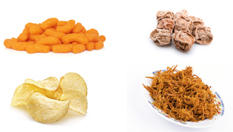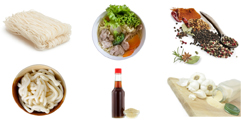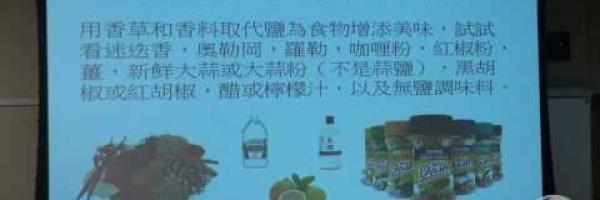Lowering Sodium in Your Diet
請點擊此轉換成中文
El Camino Health's Chinese Health Initiative physicians point out that a high sodium diet could be one of the negative factors contributing to hypertension. They suggest that people change their dietary habits to prevent and control high blood pressure.
The American Heart Association shows that the sodium in salt can affect your health and appearance. Excess levels of sodium can disrupt the balance between sodium and water within your body; this may increase water retention, leading to puffiness and bloating. Excess levels of sodium may also make your heart and blood vessels work harder, which then increases your risk of diseases such as high blood pressure, stroke and heart failure.
Food is an integral aspect of Chinese culture. Creating meals that are both nutritious and tasty is of genuine concern. Barbara Chang, nutritionist and manager of the Nutrition Department at El Camino Hospital provides tips about how to reduce sodium without sacrificing taste when you make Chinese dishes at home.
Click to download these tips.
- Americans eat on average about 3,300mg of sodium a day. The Dietary Guidelines for Americans recommend reducing sodium intake to less than 2,300mg per day (about 1 teaspoon of table salt), and adults with hypertension should further limit sodium to 1,500mg a day. Too much sodium can increase your blood pressure.
- High blood pressure makes the heart work harder. This can cause damage to blood vessels and organs like the kidneys, which increases risk for heart disease, stroke, and kidney disease.
- According to the World Health Organization, decreasing salt intake from 10g to 5g per day would reduce overall stroke rate by 23 percent and cardiovascular disease rate by 17 percent.
| ✖ Instead of this... | ✔ Eat this! |
|---|---|
Canned Food Salt can be used as preservative. Canned food that does not taste salty may contain a lot of sodium. A can of corn has 1,000mg sodium — almost half of the daily recommended intake. 3 small slices of canned meat has up to 1,000-2,000mg. | Reduced Sodium Canned Food, Fresh Food "Low" or "Reduced Sodium" canned foods contain 25-50% less sodium than regular ones. Tip: Draining and rinsing canned food can remove some extra salt. |
Preserved Food Not only are many preserved foods high in sodium, they are also high in saturated fat (e.g Chinese sausage, and bacon) and cholesterol. Preserved egg is made from duck egg. Its cholesterol content (600mg) is 3 times that of chicken egg and twice the daily recommendation. | Fresh Meat, Hard Boiled Egg, Fresh Vegetables Fresh meat, vegetables and eggs not only contain less sodium, they are also more nutritious. Tip: Avoid using pre-made sauces to cook or marinate; use fresh ginger, green onion, garlic, cilantro, lemon juice to add flavors. |

|

|
Snacks Adding a lot of salt and high sodium flavoring powder is common in the process of making snacks. It is very easy to overeat snacks because of their small serving sizes. | Fresh Fruit, Dried Fruit, Plain Nuts & Seeds Fresh or dried fruit is very low in sodium and loaded with vitamins, minerals and fiber. Nuts contain heart healthy unsaturated fat. Tip: Plain nuts and seeds have less sodium than salted ones. Look for no/low added sugar for dried and canned fruits. |

|

|
Instant/Cup Noodles Instant noodles are convenient. But their flavoring powder contains a lot of sodium. Fried instant noodles are also high in saturated fat. 1 pack/cup of instant noodles contains 1,500-2,000mg sodium, almost reaching your daily recommended intake. | Non-deep Fried Noodles with Low Sodium Chicken Broth Rice noodles, vermicelli, udon and egg noodles are good alternatives. Use low sodium chicken broth or homemade broth as the soup base. Tip: Use garlic powder, onion powder, sesame oil, sesame, white pepper, chili pepper to add flavor to noodles. |

|

|
Packaged Soup & Bouillon Cubes Broth can be used in a variety of dishes: stew, soup, sauce, soup base for noodles and hot pot. Packaged soup and bouillon cubes are often used to make broth. But they contain 500mg sodium per cup and 800-1,200mg per cube. | Low/Reduced Sodium Broth & Bouillon Cubes, Homemade Chicken Stock Tip: To save time, make a large portion and freeze homemade stock in several containers. |

|

|
